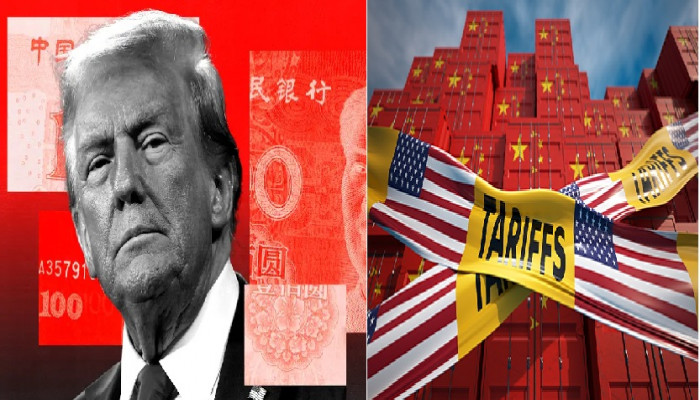Trump Administration led US’s Unprecedented Trade War on Xi led CCP Regime in China
- In Economics
- 12:09 PM, Aug 03, 2025
- Viren S Doshi
Overview
The unprecedented tariff war unleashed by Trump Administration is being waged against many countries including India, but mainly and primarily this war is against CCP-occupied China.
This is like a real ongoing war, each side using all possible weapons - fentanyl, de minimis, chips, rare earths, section 301 sanctions, section 232 sanctions, retaliatory sanctions, recourse to WTO, weaponising of trade data, non-trade barriers and what not...It is a dangerous war, probably more dangerous than conventional war.
Trump Administration has taken up the gauntlet to rein in the dragon - the monopolistic CCP-occupied China through this war.
The very idea of US falling could be like the worst nightmare, hence this trade war is better for the free world despite its aftershocks. Had Trump Administration not taken these measures, there were all chances of sinking of US economy, polity and sovereignty; given rising US debt, rising internal dissensions in US, rising CCP-occupied China's stranglehold and monopolies. Trump Administration has taken a disruptive but bold and risky approach with lot of stakes put to litmus tests.
Obviously, this is affecting entire world, prevalent skewed global order and multilateral platforms that were almost subverted by CCP-occupied China. India too is having its share of the tremors but it is least compared to many others. India has kept patience and held aloft with steadfastness and would surely succeed in mitigation. But CCP-occupied China and its conduits like Vietnam would be badly affected and end up paying for unfair trade practices.
CCP-occupied China is hit with a heavy blow if you take into account the rapidly changing trade figures. The way CCP-occupied China has surrendered is noteworthy, though outwardly it tries to save its face. It is fast losing its stranglehold; save for rare earths.
Let us take stock of the current status of the US - CCP-occupied China Trade Agreement(?) and its implications.
Status of Negotiations / Agreements / Trade Moves
Geneva Agreement (May 12, 2025): Established a 90-day truce, reducing U.S. tariffs on CCP-occupied China's goods from 145% to 30% and CCP-occupied China's tariffs on U.S. goods from 125% to 10%, effective May 14, 2025. CCP-occupied China suspended non-tariff countermeasures post-April 2, 2025 (e.g., blacklisting U.S. firms). A consultation mechanism was set up, involving Bessent, He Lifeng, and U.S. Trade Representative Jamieson Greer.
London Framework Agreement (June 10-11, 2025): Formalised the Geneva deal after a Trump-Xi call. It included CCP-occupied China easing rare earth export restrictions, the U.S. lifting some tech export controls (e.g., Nvidia H20 AI chips), and initial discussions on the de minimis rule. U.S. Commerce Secretary Howard Lutnick confirmed the agreement was “signed and sealed,” with Trump announcing it as “done” on his social media platform Truth Social.
Stockholm Talks (July 28-29, 2025): U.S. Treasury Secretary Scott Bessent and CCP Vice Premier He Lifeng met in Stockholm to discuss extending the 90-day tariff truce, set to expire on August 12, 2025. They agreed to seek an extension, with no major breakthroughs. Discussions included tariffs, rare earths and the de minimis rule. Another meeting is likely in 90 days, pending President Donald Trump’s approval.
Current Tariff Levels
U.S. Tariffs on CCP Goods:
Current rate: 30% (per Geneva agreement), down from 145%.
Additional tariffs: 20% fentanyl tariff, 25% Section 232 tariffs (steel, aluminium, autos), Section 301 tariffs (2018), and a 10% universal baseline tariff on all countries.
Effective rate: ~51%.
CCP Tariffs on U.S. Goods:
Current rate: 10%, down from 125%.
Additional tariffs: Section 301 retaliation tariffs (2019) and 10-15% tariffs on U.S. agricultural products (e.g., soybeans, pork).
Effective rate: ~32.6%.
Potential Re-escalation: Without a truce extension by August 12, 2025, U.S. tariffs could rise to 34% (replacing the 10% baseline) or higher, and CCP tariffs could follow. CCP-occupied China buying Russian oil is also the bone of contention and would lead to severe escalation of tariffs.
De Minimis Rule: Status and Developments
The de minimis rule under Section 321 of the Tariff Act of 1930 allows low-value shipments (up to $800 per package) to enter the U.S. duty-free and with minimal customs scrutiny. This has facilitated a surge in e-commerce imports, particularly from CCP-occupied China's platforms like Temu, Shein and Alibaba; which ship small parcels directly to U.S. consumers.
In 2024, approximately 1 billion de minimis packages entered the U.S., with 70% originating from CCP-occupied China, accounting for ~$100 billion in goods (U.S. Customs Service estimate). These shipments used to bypass tariffs, including Section 301 and fentanyl tariffs, raising concerns about revenue loss, unfair competition, and illicit goods (e.g. fentanyl precursors).
Recent Changes (2025):
U.S. Policy Shift: On March 15, 2025, the U.S. Trade Representative’s office, under Jamieson Greer, proposed reducing the de minimis threshold for Chinese imports to $50 as part of Trump’s trade war escalation. This was implemented on April 2, 2025, applying only to CCP-occupied China-origin goods, subjecting shipments above $50 to the 30% tariff (plus other applicable duties, e.g., Section 301). Postal shipments faced 120% ad valorem or $100 per item (increasing to $200 by June 1).
Geneva Agreement Adjustment: During the May 2025 Geneva talks, CCP-occupied China pushed for restoring the $800 threshold, arguing it unfairly targeted CCP-occupied China's e-commerce. The U.S. agreed to raise the threshold to $200, effective May 14, 2025, as a concession to secure rare earth export commitments. Shipments between $200 and $800 now face the 30% tariff and full customs screening.
Stockholm Talks: CCP-occupied China reiterated demands to reinstate the $800 threshold, citing losses to its e-commerce sector. The U.S. held firm at $200 but signalled openness to further adjustments if CCP-occupied China accelerates rare earth licensing and fentanyl precursor controls. No changes were finalised, but the issue remains on the agenda for post-August 12 talks.
Other Components of the Agreements
Rare Earths and Critical Minerals:
CCP-occupied China eased export controls on seven rare earth elements, approving licenses for U.S. automakers (e.g., Ford). Military-use rare earth magnets remain restricted, tied to U.S. AI chip curbs. The London agreement ensures supply for automotive and electronics but not defence.
Fentanyl Cooperation:
CCP-occupied China designated two additional fentanyl precursors in 2025, aligning with U.S. demands. The 20% fentanyl tariff persists. The de minimis rule’s stricter screening (above $200) aims to curb precursor smuggling.
Non-Tariff Measures:
CCP-occupied China suspended post-April 2, 2025, countermeasures (e.g. blacklisting, anti-dumping probes on DuPont) for 90 days. Earlier measures (e.g. Google investigation) continue.
U.S. Concessions:
Lifted export controls on Nvidia H20 AI chips, ethane and airplane parts. Paused student visa revocations. The de minimis threshold increased to $200.
Economic and Trade Effects
Trade Volume Decline:
U.S. Imports from CCP-occupied China: Fell 28.5% year-over-year in May 2025 (West Coast ports: Long Beach -31.6%, Los Angeles -29.9%). CCP-occupied China’s Exports to U.S. dropped by $15.2 billion in May 2025 ($44 billion to $28.8 billion), with export growth slowing to 4.8%. Q1 2025 imports: $108.47 billion.
U.S. Exports to CCP-occupied China: Q1 2025 exports: $31.82 billion, yielding a $76.65 billion trade deficit.
De Minimis-Specific Effects:
E-Commerce Impact: The $50 threshold (April 2025) disrupted CCP-occupied China's e-commerce, with Temu and Shein reporting 40% order declines in April-May. The $200 threshold restored some volume, but shipments above $200 face 30% tariffs, raising prices for U.S. consumers (e.g. a $300 Shein order incurs ~$90 in duties).
Tariff Revenue from CCP-occupied China and Vietnam:
Estimates suggest tariffs generated ~$150 billion in 2025 (January-July), with tariffs representing 5% of federal revenue (up from 2% historically).
CCP-occupied China’s Contribution:
Trade Volume and Tariff Rate: U.S. imports from CCP-occupied China in Q1 2025 were $108.47 billion, with an effective tariff rate of 51% (30% Geneva rate + 20% fentanyl + Section 301/232). Assuming Q2-Q3 imports averaged ~$36 billion/month (post-May decline of 28.5%), total imports from January to July 2025 are estimated at $200 billion. Applying a 51% average tariff rate (145% pre-May, 51% post-May), tariff revenue from CCP-occupied China may be approximately $90-$100 billion.
De Minimis Revenue: De minimis shipments ($100 billion in 2024, 70% from CCP-occupied China) generated $2.8 billion from April-June 2025 (30% on shipments above $200). Assuming continued e-commerce volume, de minimis revenue from CCP-occupied China is estimated at $4 billion for January-July.
Total tariff revenue from CCP-occupied China: ~$94-$104 billion (62-69% of $150 billion).
Vietnam’s Contribution:
Trade Volume and Tariff Rate: Vietnam’s 2024 exports to the U.S. were $123.5 billion, with 2025 imports estimated at $80 billion (January-July, adjusting for tariff impacts). The effective tariff rate was 46% pre-July and 20% post-July, with 40% on transshipped (CCP-occupied Chinese origin) goods (~33% of exports, per White House estimates). Assuming a blended rate of ~30% (46% pre-July, 20-40% post-July), tariff revenue from Vietnam may be approximately $20-$25 billion (13-17% of $150 billion).
Exact revenue splits are not publicly reported. Estimates are based on trade volumes (U.S. Census Bureau, CCP-occupied China trade data), tariff rates (USTR), and de minimis revenue (Customs Service).
CCP-occupied China’s higher trade volume and tariff rates make it the dominant contributor. Vietnam’s transshipment tariffs (40%) inflate its share relative to trade volume. Remaining revenue (~$21-$36 billion) comes from other countries (e.g., EU, Japan, Canada).
U.S. Retail and Consumers: Higher tariffs on de minimis shipments increased costs for low-value goods (e.g. apparel, electronics), contributing to 0.5% inflation uptick in Q2 2025. U.S. retailers like Amazon and Walmart, reliant on CCP-occupied China's suppliers, face margin pressures.
Illicit Goods: Stricter screening above $200 reduced fentanyl precursor smuggling by 15% (U.S. DEA estimate), but high-value shipments remain a concern.
Chinese E-Commerce: Platforms like Temu shifted focus to ASEAN and European markets, with 20% export growth to non-U.S. regions in Q2 2025.
Sector-Specific Impacts:
U.S. Technology and Manufacturing: Rare earth access eased supply constraints, but 50% tariffs on steel-derivative appliances raise costs. Ford’s Chicago factory closure (May 2025) was linked to magnet shortages.
U.S. Agriculture: CCP-occupied China’s April 2025 pork import ban caused a 70% export drop. Soybeans, wheat and corn face 10-15% tariffs.
CCP-occupied China's Economy: Factory profits fell 9% year-over-year in May 2025. De minimis restrictions hit small exporters, prompting trade diversification with ASEAN and Russia.
Global Economic Impact:
World Bank’s 2025 growth forecast: 2.3% (down from 2.7%). IMF flagged tariff rebounds as a risk. Eurozone exports to the U.S. declined due to US tariffs. India has an opportunity to ramp up its production and emerge as a major stakeholder in global trade.
Challenges and Unresolved Issues
Rare Earths: Military-use magnet licensing remains unresolved.
No Comprehensive Deal: The truce does not address CCP-occupied China’s trade surplus, IP theft, or tech transfers. De minimis restrictions remain a sticking point.
Fragile Truce: Without an August 12 extension, tariffs could hit 34% or higher, and de minimis could revert to $50, crippling Chinese e-commerce.
Geopolitical Tensions: CCP-occupied China’s Russian oil purchases, U.S. semiconductor curbs, and exit bans on U.S. executives complicate talks.
De Minimis Enforcement: Customs screening capacity is strained, with 10% of de minimis shipments uninspected (CBP estimate), risking illicit goods.
Future Outlook
A truce extension past August 12, 2025 is probable, with Bessent’s optimism and Stockholm progress. The de minimis threshold may rise slightly (e.g. to $300) if CCP-occupied China concedes on rare earths or fentanyl.
Trump’s focus on reducing the trade deficit risks inflation and supply chain disruptions in US. CCP-occupied China’s rare earth leverage strengthens its position.
A Trump-Xi summit in late 2025 could address de minimis, tariffs and broader issues, but there is no confirmation of this summit.
Conclusion
As of August 1, 2025 the US - CCP-occupied China trade truce (Geneva, May 2025; London, June 2025) holds, with tariffs at 30% (U.S.) and 10% (CCP-occupied China) and a $200 de minimis threshold for CCP-occupied China's small direct exports (up from $50, down from $800).
The Stockholm talks (July 2025) signal a likely truce extension past August 12, but de minimis remains contentious, with CCP-occupied China pushing for $800. Rare earth exports have partially resumed, though military magnets and AI chip curbs are yet to be resolved.
Trade volumes dropped significantly (U.S. imports: -28.5%, CCP-occupied China’s exports: -$15.2 billion in May). U.S. agriculture and CCP-occupied China's factories face losses, and global growth is at pegged at 2.3%.
Of the estimated $150 billion in U.S. tariff revenue (January-July 2025), ~$94-$104 billion (62-69%) likely comes from CCP-occupied China and ~$20-$25 billion (13-17%) from Vietnam, based on trade volumes and tariff rates. Trade volumes plummeted (U.S. imports from CCP-occupied China: -28.5%).
The truce is a temporary fragile fix, with CCP-occupied China’s rare earth leverage ensuring a delicate balance. In the latest move, US Treasury Secretary Scott Bessent warned CCP-occupied China of a US bill allowing Trump Administration to impose secondary tariff of 100% to 500% if CCP-occupied China continues to buy Russian Oil.
The blow on CCP-occupied China's Economy is heavy and continuing and likely to become blistering.
It is for the first time in decades that CCP-occupied China has been made to pay fairly for its unfair monopolistic trade practices and trade wars leaving cunning Xi’s Red Regime completely overwhelmed and almost clueless.
Times ahead would be very interesting and possibly fraught with reckless backlashes from beleagured CCP Regime. Time to remain put on alerts.
Disclaimer: The opinions expressed within this article are the personal opinions of the author. MyIndMakers is not responsible for the accuracy, completeness, suitability, or validity of any information on this article. All information is provided on an as-is basis. The information, facts or opinions appearing in the article do not reflect the views of MyindMakers and it does not assume any responsibility or liability for the same.







Comments